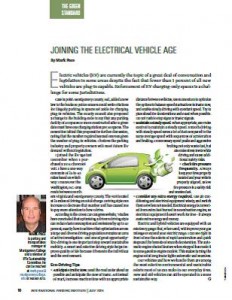Electric vehicles (EV) are currently the topic of a great deal of conversation and legislation in some areas despite the fact that fewer than 1 percent of all new vehicles are plug-in capable. Enforcement of EV charging-only spaces is a challenge for some jurisdictions.
Case in point: Montgomery County, Md., added a new law to the books so police officers could write citations for illegally parking in spaces set aside for charging plug-in vehicles. The county council also proposed a change to the building code to say that any parking facility of 50 spaces or more constructed after a given date must have one charging station per 50 spaces. The committee tabled this proposal for further discussion, noting that the number required seemed onerous given the number of plug-in vehicles. I believe the parking industry and property owners will meet future EV demand without legislation.
I joined the EV age last December when I purchased a 2014 Chevrolet Volt. I have a one-way commute of 35 to 40 miles based on which way I maneuver the Washington, D.C.-area roads between Northern Virginia and Montgomery County. The Volt is rated at 35 miles of driving on a full charge. Driving style can increase or decrease that number and has caused me to pay more attention to how I drive.
According to the Green Car Congress website, “Studies have concluded that optimizing a driver’s driving style can reduce fuel consumption and emissions by up to 40 percent; exactly how to achieve that optimization across a large and diverse driving population remains an area of active investigation—and one of great opportunity.” Eco-driving is one important step toward sustainable mobility. A smart and effective driving style helps improve quality of life because it benefits the individual and the environment.
Eco-Driving Tips
- Anticipate traffic flow. Read the road as far ahead as possible and anticipate the flow of traffic. Act instead of react, increase reaction time with an appropriate distance between vehicles, use momentum to optimize the options to balance speed fluctuations in traffic flow, and enable steady driving with constant speed. Try to plan ahead for decelerations and coast when possible. Do not rush to stop signs or traffic signals.
- Maintain a steady speed. When appropriate, use cruise control to maintain a steady speed. Smooth driving with steady speed saves a lot of fuel compared to the same average speed with sequences of acceleration and braking. Unnecessary speed peaks and aggressive braking not only waste fuel, but also raise stress levels while driving and cause additional safety risks.
- Check tire pressure frequently. Always keep your tires properly inflated and your vehicle properly aligned, as low tire pressure is a safety risk and wastes fuel.
- Consider any extra energy required. Use air conditioning and electrical equipment wisely, and switch them off when not needed. Electrical energy is converted from extra fuel burned in a combustion engine, so electrical equipment doesn’t work for free—it always costs extra energy and money.
Electric and hybrid vehicles are equipped with an efficiency gauge that, when used, will improve your gas mileage or extend your electric range. I can see right in front of me the effects of rapid acceleration and quick stops and the benefits of smooth deceleration. The automatic engine shutoff feature when stopped has made it to some gasoline engine models. This makes turning the engine off at long traffic lights automatic and seamless.
Our vehicles and how we handle them are among the most effective environmental and sustainable efforts most of us can make in our everyday lives. New and old vehicles can all be operated in a more sustainable way.
Mark Pace is parking and transportation manager at Montgomery College and a member of IPI’s Sustainability Committee. He can be reached at mark.pace@montgomerycollege.edu or 240.567.4213.
TPP-2014-07-Joining the Electrical Vehicle Age

